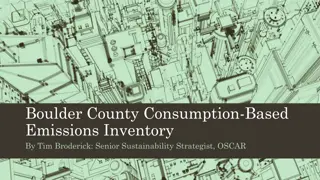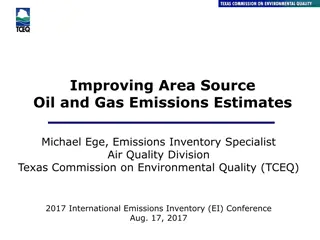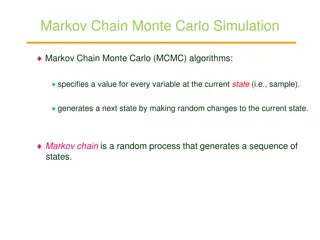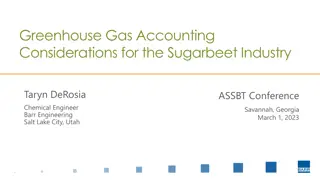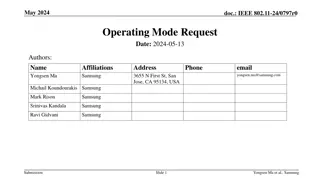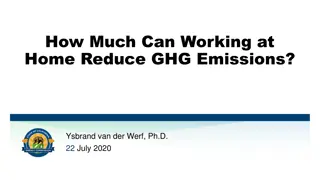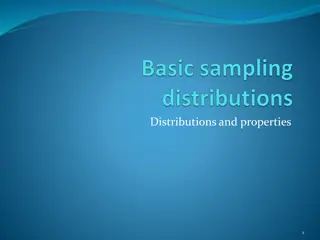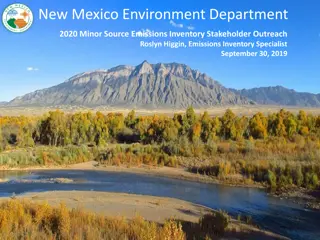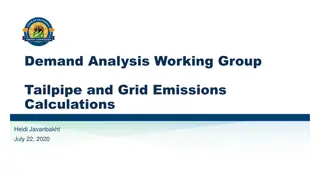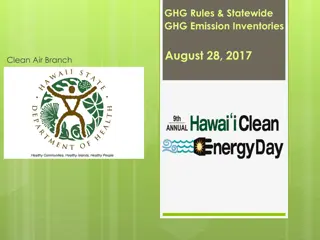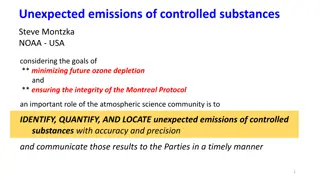Modelling GHG Emissions in Greater Toronto Area Using Link-Based Operating Mode Distributions
The Transportation & Air Quality Research Group's study focuses on generating a lifecycle emission inventory for transportation in the Greater Toronto Hamilton Area (GTHA). They aim to incorporate uncertainty in the emission inventory and quantify the impact of electric vehicles on total emissions. The research methodology involves utilizing data from MOVES, GREET, MTO vehicle registration, and various scenarios for electricity generation in Ontario. The study explores the distribution of emission factors derived from AIMSUN and applied within EMME. Additionally, it analyzes the MTO vehicle composition from 2016 and different electricity generation scenarios in Ontario.
Download Presentation

Please find below an Image/Link to download the presentation.
The content on the website is provided AS IS for your information and personal use only. It may not be sold, licensed, or shared on other websites without obtaining consent from the author.If you encounter any issues during the download, it is possible that the publisher has removed the file from their server.
You are allowed to download the files provided on this website for personal or commercial use, subject to the condition that they are used lawfully. All files are the property of their respective owners.
The content on the website is provided AS IS for your information and personal use only. It may not be sold, licensed, or shared on other websites without obtaining consent from the author.
E N D
Presentation Transcript
TRAQ The Transportation & Air Quality Research Group Modelling GHG Emissions in the GTHA Using Link-Based Operating Mode Distributions as a Proxy for Driving Behaviour An Wang, Christos Stogios, Yijun Gai, James Vaughan, Gozde Ozonder, SeungJae Lee, Daniel Posen , Eric J. Miller, Marianne Hatzopoulou
Research Objectives Generate a lifecycle emission inventory for transportation in the GTHA Incorporate uncertainty within emission inventory Quantify the effects of electric vehicles on total emissions 2
Methods and data Based on MOVES and GREET with local inputs Vehicle registration data from MTO Various scenarios for electricity generation in Ontario Hybrid approach using distributions of emission factors derived from AIMSUN and applied within EMME 4
Methods and data Based on MOVES and GREET with local inputs Vehicle registration data from MTO Various scenarios for electricity generation in Ontario Hybrid approach using distributions of emission factors derived from AIMSUN and applied within EMME 5
Methods and data Based on MOVES and GREET with local inputs Vehicle registration data from MTO Various scenarios for electricity generation in Ontario Hybrid approach using distributions of emission factors derived from AIMSUN and applied within EMME 7
Electricity generation scenarios Ontario electricity generation mix obtained from the Independent Electricity System Operator (IESO) Four electricity generation scenarios: 1. Current Ontario mix: 61% nuclear, 23.7% hydro, 8.4% gas/oil, 6.2% wind, 0.3% biofuel, 0.3% solar 2. All fossil mix: 100% natural gas 3. Only dispatchable source mix: 73% hydro, 26% gas/oil, and 1% biofuel 4. Solar and wind mix: 95.3% wind and 4.7% solar 8
Methods and data Based on MOVES and GREET with local inputs Vehicle registration data from MTO Various scenarios for electricity generation in Ontario Hybrid approach using distributions of emission factors derived from AIMSUN and applied within EMME 9
Motivation for hybrid approach Two types of EFs in MOVES By gram per unit time Based on single operating mode; Requires instantaneous speed to estimate emissions Based on default driving cycles (built-in operating mode distribution); Only requires average speed to estimate emissions Various drive cycles can occur at the same average speed By gram per unit distance A distribution of emission factors for each average speed makes more sense 10
Proposed approach 1. Select n random roads to run microsimulation Test area: City of Toronto 2. Sample of roads includes arterials, ramps and freeways For link i in each road type, generate an operating mode distribution and calculate total emissions ?? based on instantaneous speeds 3. With instantaneous speed: Link-level total emission; Link-level EF; Link average speed; ?? Generate EF of link i: ???= refers to the vehicle miles travelled on link i 4. ????, ???? 5. Generate distributions of EFs by average speed bins 11
PM-Peak Distribution of EFs No freeway data 13
Midday Distribution of EFs No freeway data 14
Evening Distribution of EFs No freeway data 15
Results 16
Daily GHG Emissions in GTHA 30000 25000 Daily GHG Emission (tonnes) 8391 20000 95% of total emissions 15000 10000 19376 5000 277 1119 0 Transit Private Vehicles Operating Emissions (tonne) Upstream Emissions (tonne) 17
Comparison with Public Transit Green bar illustrates the range of private vehicle emission intensities Colored boxes illustrate the ranges of public transit emission intensities 18
Spatial distribution of emissions AM Midday 19
Daily Fuel-Cycle Stochastic Inventory From single number to distribution Daily Fuel-Cycle Emissions (gram) 20
Base case Scenario 1: Current electricity mix 21
Base case Scenario 2: Natural Gas 22
Base case Scenario 3: Dispatchable sources 23
Base case Scenario 4: Renewables 24
BUT: Deep reductions in traffic emissions may not be achieved without large investments in public transit Emission intensities for electric vehicles are: 1. Current Ontario mix 12.8, 130.1, 37.2, and 2.8 g CO2eq/km for passenger cars 2. All fossil mix: 100% natural gas 3. Only dispatchable source mix: 73% hydro, 26% gas/oil, and 1% biofuel 14.6, 149, 42.6, and 3.2 g CO2eq/km for passenger trucks w 4. Solar and wind mix: 95.3% wind and 4.7% solar with electricity mix 1 to 4 respectively Emission intensity for transit (right now with mostly transit buses which are diesel fuelled) is 18.5 g/PKT (daily average) 25
Limitations of previous approach Distributions of emissions that we developed for each average speed should be refined Std. Dev. of speed, delay, other measures? There is no need to group links by average speed, why not a cluster approach? 27
Full network mesoscopic + sample microsimulation 29
Clustering is based on meso traffic variables: average speed, standard deviation of speed, average delay, standard deviation of delay, Road capacity Segment density Vehicle kilometers travelled 30
In full network, mesoscopic data are available. Assign a cluster to each segment in the full network Apply representative EF and estimate total emissions 34
Downtown Toronto GHG estimation: Hybrid VS microscopic model Hybrid estimation: 67.4 - 74.3 tons Microscopic estimation: 70.06 tons Mesoscopic estimation: 49.04 tons 35






